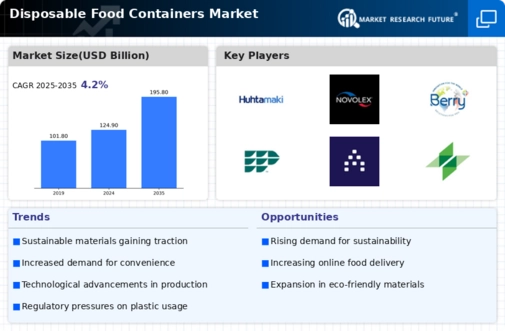Market Growth Projections
The Global Disposable Food Containers Market Industry is poised for substantial growth, with projections indicating a market value of 124.9 USD Billion in 2024 and an anticipated increase to 195.8 USD Billion by 2035. This growth trajectory suggests a robust compound annual growth rate (CAGR) of 4.17% from 2025 to 2035. The increasing demand for convenience, coupled with sustainability initiatives and advancements in technology, underpins this positive outlook. As the market evolves, it is likely to witness diversification in product offerings, catering to a wide range of consumer preferences and regulatory requirements.
Sustainability Initiatives
Sustainability emerges as a pivotal driver in the Global Disposable Food Containers Market Industry. With heightened awareness regarding environmental issues, consumers and businesses alike are gravitating towards eco-friendly packaging solutions. Many manufacturers are now focusing on biodegradable and compostable materials, aligning with global sustainability goals. This shift is not merely a trend but a necessity, as regulations around plastic usage tighten worldwide. The industry's adaptation to sustainable practices could potentially enhance its market appeal, attracting environmentally conscious consumers and businesses. As a result, the market is likely to witness a significant transformation in product offerings.
Rising Demand for Convenience
The Global Disposable Food Containers Market Industry experiences a notable surge in demand for convenience-oriented packaging solutions. As lifestyles become increasingly fast-paced, consumers favor ready-to-eat meals and takeout options. This trend is reflected in the projected market value of 124.9 USD Billion in 2024, indicating a strong inclination towards disposable food containers that facilitate on-the-go consumption. The convenience factor not only appeals to individual consumers but also to food service providers, who seek efficient packaging to enhance customer satisfaction. This growing preference for convenience is likely to drive innovation and expansion within the industry.
Growth in Food Delivery Services
The Global Disposable Food Containers Market Industry is significantly influenced by the expansion of food delivery services. The rise of online food ordering platforms has created a robust demand for disposable containers that ensure food safety and quality during transit. This trend is expected to contribute to the market's growth, with projections indicating a market value of 195.8 USD Billion by 2035. As food delivery services continue to proliferate, the need for reliable and efficient packaging solutions becomes paramount. Consequently, manufacturers are likely to innovate and diversify their product lines to meet the evolving needs of this burgeoning sector.
Technological Advancements in Packaging
Technological advancements play a crucial role in shaping the Global Disposable Food Containers Market Industry. Innovations in materials and manufacturing processes are enabling the production of more durable, lightweight, and cost-effective containers. For instance, advancements in polymer technology have led to the development of containers that can withstand extreme temperatures, making them suitable for a variety of food applications. These improvements not only enhance product performance but also contribute to cost savings for manufacturers. As technology continues to evolve, it is expected that the industry will see a rise in the introduction of smart packaging solutions, further driving market growth.
Increasing Urbanization and Population Growth
Urbanization and population growth serve as significant drivers for the Global Disposable Food Containers Market Industry. As more individuals migrate to urban areas, the demand for convenient food options rises correspondingly. This demographic shift is accompanied by an increase in disposable income, enabling consumers to spend more on ready-to-eat meals and takeout. The market is projected to grow at a CAGR of 4.17% from 2025 to 2035, reflecting the sustained demand for disposable food containers. Urban lifestyles often prioritize convenience, thereby fostering a favorable environment for the growth of the disposable food container sector.











